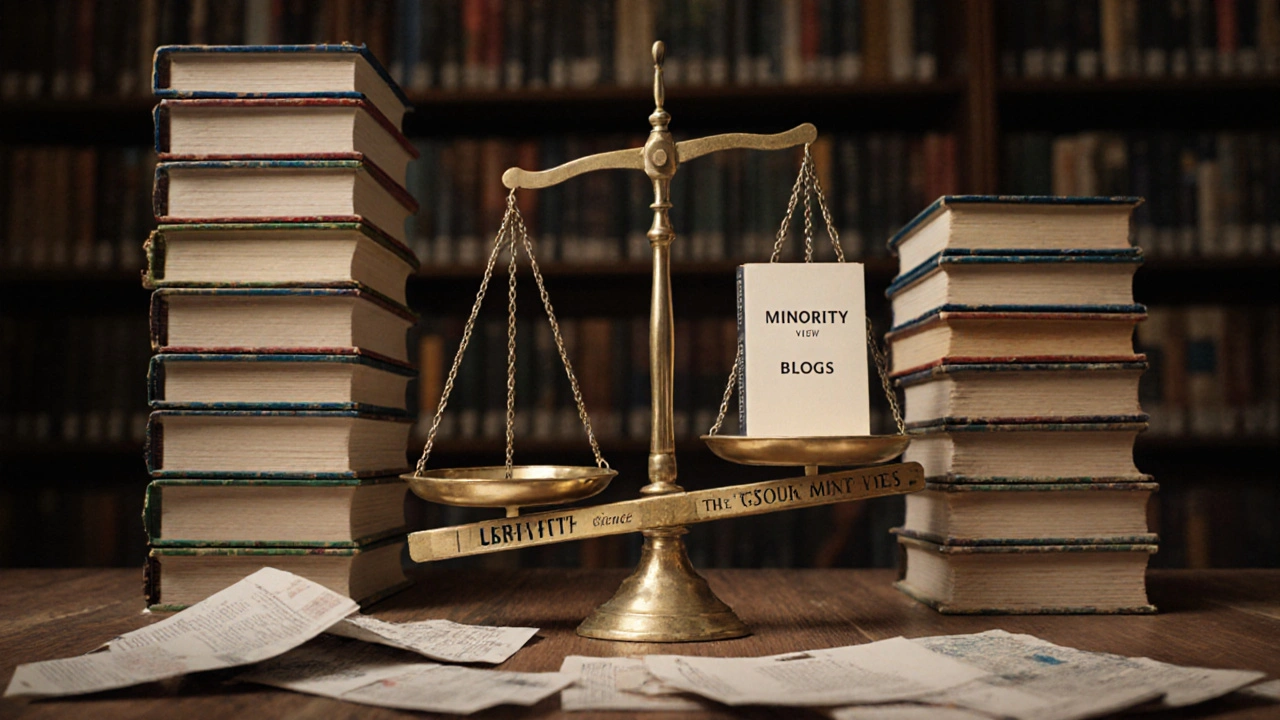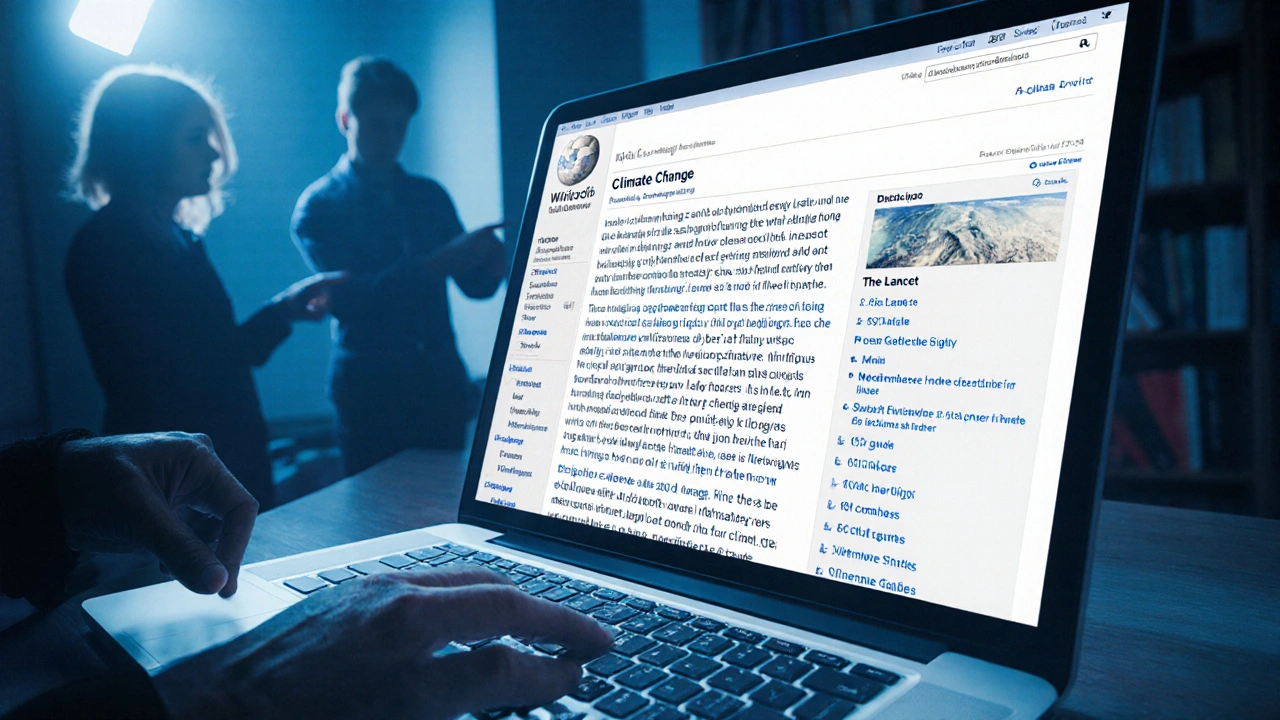
Wikipedia doesn’t report facts alone-it reports what reliable sources say. But what happens when those sources disagree? That’s where due weight comes in. It’s not about giving every opinion equal space. It’s about giving each view the space its prominence in reliable sources deserves. Too much space to a fringe idea? That misleads readers. Too little to a well-supported minority view? That’s censorship by omission.
What Due Weight Actually Means
Due weight is Wikipedia’s way of ensuring articles reflect the real landscape of published knowledge. If 90% of peer-reviewed studies support climate change being human-caused, then the article should reflect that. But if 10% of credible scientific literature presents a different, well-researched interpretation, that too belongs-not as a footnote, but as a meaningful part of the discussion.
This isn’t about popularity contests. It’s about sourcing. A blog post with 10,000 shares doesn’t count. A 2023 meta-analysis in The Lancet does. A 1998 opinion piece in a regional newspaper? Only if it’s cited by later, authoritative sources. The key is: what do reliable, published sources say-and how much space do they give to each position?
When Minority Views Are Actually Major
Some views are minority in the public eye but dominant in academic circles. Take the theory that the Earth is round. In 2025, most people accept it. But in 1950, a small but vocal group in the U.S. still pushed flat-Earth claims. Wikipedia wouldn’t give those claims equal space today-not because they’re wrong, but because they’re not supported by credible sources anymore.
Conversely, consider the historical consensus on tobacco and cancer. In the 1950s, tobacco companies funded studies that downplayed the link. Those studies were published. But by the 1970s, hundreds of peer-reviewed papers confirmed the danger. Wikipedia’s article on smoking and cancer doesn’t give equal weight to the tobacco industry’s old claims. It gives them context: "Some industry-funded studies in the 1960s disputed the link, but these were later discredited by larger, independent studies."
That’s due weight: acknowledging the existence of opposing claims without legitimizing them as equally valid.
Common Mistakes Editors Make
Editors often misapply due weight in three ways.
- False balance: Giving 50% of the text to a view supported by 5% of sources. This happens often in articles about vaccines, evolution, or election integrity. The result? Readers think the science is evenly split when it’s not.
- Erasing minority views: Ignoring a well-documented perspective because it’s unpopular. For example, some Indigenous oral histories about land use are dismissed as "not scientific." But if anthropologists and historians have published peer-reviewed work using those sources, they deserve space.
- Overloading with citations: Listing every minor source without synthesis. An article shouldn’t read like a bibliography. It should tell the story behind the sources.
The fix? Ask: "What do authoritative sources say, and how much space do they give each side?" Then mirror that in the article.

Real Examples from Wikipedia
Take the article on Climate change. The introduction states clearly: "The overwhelming majority of climate scientists agree that human activities are the primary driver of recent global warming." That’s not opinion-it’s a summary of assessments by the IPCC, NASA, NOAA, and over 200 scientific societies.
But the article doesn’t ignore dissent. A dedicated section, titled "Scientific dissent," lists organizations that have published minority views, with context: "These groups are not climate science organizations," or "Their publications have not been replicated in peer-reviewed literature." That’s due weight in action.
Another example: the article on Gender identity. It includes perspectives from medical associations, legal scholars, and advocacy groups. It doesn’t give equal space to anti-trans activist blogs. But it does include the views of organizations like the American Psychological Association and the World Professional Association for Transgender Health-because those are the sources that shape medical and legal policy.
How to Apply Due Weight When Editing
If you’re editing a Wikipedia article and spot a balance issue, here’s how to fix it:
- Identify the competing claims. What are the main positions?
- Find the most reliable sources for each. Use academic journals, government reports, major news outlets, and authoritative books-not blogs, social media, or opinion columns.
- Count the volume and prominence. How many high-quality sources support each view? Are they from respected institutions?
- Reorganize the text. Give proportionate space. If 80% of credible sources support View A, and 20% support View B, structure the article so View A gets the bulk of the explanation, and View B gets a clear, contextualized section.
- Add context. Don’t just say "some people believe X." Say: "A 2022 study in Science found X, but this was challenged by a 2023 meta-analysis in Nature that included 120 additional datasets."
Always cite. Never assume. And never let your personal beliefs dictate the structure.

Why This Matters Beyond Wikipedia
Wikipedia is often the first place people look for answers. If it misrepresents the balance of evidence, it spreads misinformation-not by lying, but by misleading. A student reading an article that falsely equates climate science with denialism might grow up thinking the debate is still open. A parent researching vaccines might walk away thinking the risks are equal to the benefits.
Due weight protects readers from distortion. It’s not about being neutral. It’s about being accurate. Wikipedia’s strength isn’t that it’s unbiased-it’s that it’s sourced. And sourcing means giving each side its due.
What Happens When Due Weight Is Ignored
In 2021, a Wikipedia article on a controversial medical treatment gained traction after edits by a group of activists. They removed all references to major health agencies’ warnings and replaced them with personal testimonials and low-quality blogs. The article was eventually protected and restored after months of dispute.
That’s not an isolated case. Wikipedia has over 20,000 articles flagged for neutrality issues. Many stem from due weight violations. The result? Trust erodes. Readers stop believing what they read.
Fixing this isn’t about banning opinions. It’s about demanding better sourcing. It’s about recognizing that not all voices are created equal-and that’s okay.
Final Rule: Let Sources Decide
Wikipedia’s job isn’t to pick winners. It’s to report what the world of published knowledge says. If a view is supported by credible, repeated, authoritative sources, it belongs. If it’s a one-off claim with no backing, it doesn’t.
Ask yourself before saving an edit: "Would a librarian, a professor, or a fact-checker at a major newsroom recognize this as fair representation?" If the answer is no, go back. Find better sources. Reword. Rebalance.
Due weight isn’t a rule you follow. It’s a mindset you adopt. And when you do, Wikipedia becomes not just a collection of facts-but a trustworthy guide to how the world understands them.
What is due weight on Wikipedia?
Due weight is Wikipedia’s policy that article content should reflect the relative prominence of viewpoints in reliable, published sources. It means giving more space to views supported by more credible sources, and less space to fringe or unsupported claims-not because they’re wrong, but because they’re not widely accepted in authoritative literature.
Does due weight mean all opinions get equal space?
No. Due weight is the opposite of equal space. It’s proportional representation. If 95% of peer-reviewed research supports a position, that position should dominate the article. A minority view with limited scholarly backing gets a brief, contextualized mention-not a full section.
Can a minority view be given more space on Wikipedia?
Yes-if reliable sources give it more prominence. For example, Indigenous oral histories about land use were once dismissed as anecdotal. But when anthropologists published peer-reviewed work using those sources, Wikipedia articles began including them as legitimate perspectives. The key is not popularity, but credible, documented support.
How do I know if a source is reliable enough for due weight?
Reliable sources are typically peer-reviewed journals, academic books, major newspapers, government reports, or publications from recognized institutions. Blogs, social media, self-published material, and opinion columns are not reliable unless cited by a reliable source. Check if the source has editorial oversight, citations, and a track record of accuracy.
What should I do if I see false balance in a Wikipedia article?
Edit it. Find the most credible sources for each side, assess their volume and authority, and restructure the article to reflect proportionate representation. Add context to minority views so readers understand why they’re included-and why they’re not dominant. If you’re unsure, discuss it on the article’s talk page with other editors.





